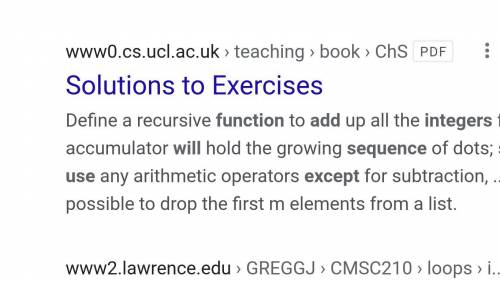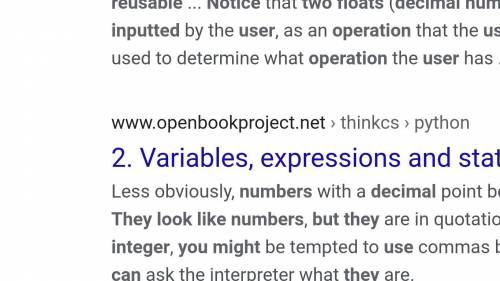WILL GIVE BRAINLEIST PLZ HELP PLZ AND THANK YOU
I WILL REPORT FAKE ANSWERS
Part A
One o...

Computers and Technology, 04.03.2021 05:10 cait8752
WILL GIVE BRAINLEIST PLZ HELP PLZ AND THANK YOU
I WILL REPORT FAKE ANSWERS
Part A
One of the biggest benefits of writing code inside functions is that we can reuse the code. We simply call it whenever we need it!
Let’s take a look at a calculator program that could be rewritten in a more reusable way with functions. Notice that two floats (decimal numbers, but they can also include integers) are inputted by the user, as an operation that the user would like to do. A series of if statements are used to determine what operation the user has chosen, and then, the answer is printed inside a formatted print statement.
num1 = float(input("Enter your first number: "))
num2 = float(input("Enter your second number: "))
operation = input("What operation would you like to do? Type add, subtract, multiply, or divide.")
if operation == "add":
print(num1, "+", num2,"=", num1 + num2)
elif operation == "subtract":
print(num1, "-", num2,"=", num1 - num2)
elif operation == "multiply":
print(num1, "*", num2,"=", num1 * num2)
elif operation == "divide":
print(num1, "/", num2,"=", num1 / num2)
else:
print("Not a valid operation.")
Your job is to rewrite the program using functions. We have already looked at a function that adds two numbers. Using that as a starting point, we could call the add function from within our program in this way:
if operation == “add”:
result = add(num1, num2)
print(num1, "+", num2,"=",result)
Now it’s your turn to do the following:
Type all of the original code into a new file in REPL. it.
Copy the add function from the unit and paste it at the top of your program.
Write 3 additional functions: subtract, multiply, and divide. Pay careful attention to the parameters and return statement. Remember to put the three functions at the top of your Python program before your main code.
Rewrite the main code so that your functions are called.
Part B
There are many different ways that a user could tell us that he or she would like to add two numbers in our calculator program. The user could type “add”, “Add”, “ADD”, or “+”, to name a few possibilities. Of course, as humans, we know exactly what is meant, even if the word is capitalized. But the Python Interpreter can’t tell that “add” is the same as “Add”.
We can use a list to make our program a bit more robust. We can also use the IN operator to check for certain values in that list. Take a look at this if statement’s opening line:
if operation in [“add”, “Add”, “ADD”, “+”]:
Make those changes in your program and verify that it works.
Consider all of the possible words the user might enter to subtract, multiply, or divide.
Rewrite the first lines of each of your if statements to use lists.
Thoroughly test your new program, trying out each of the four operations.
Share the link to your Python code in REPL. it with your teacher by clicking on the share button and copying the link.

Answers: 2


Another question on Computers and Technology

Computers and Technology, 22.06.2019 23:30
Define a function printfeetinchshort, with int parameters numfeet and numinches, that prints using ' and " shorthand. ex: printfeetinchshort(5, 8) prints: 5' 8"
Answers: 1

Computers and Technology, 23.06.2019 07:30
Which option allows you to view slides on the full computer screen?
Answers: 1

Computers and Technology, 23.06.2019 15:00
Barbara is interested in pursuing a career in the science and math pathway. which qualifications will her reach that goal? a.an advanced knowledge of physics and math b.an advanced knowledge of engineering and math c. an advanced knowledge of physics and robotics an d. advanced knowledge of machinery and math
Answers: 2

You know the right answer?
Questions



History, 19.06.2020 22:57

Spanish, 19.06.2020 22:57



Mathematics, 19.06.2020 22:57

Geography, 19.06.2020 22:57

Mathematics, 19.06.2020 22:57


Chemistry, 19.06.2020 22:57

Mathematics, 19.06.2020 22:57


Mathematics, 19.06.2020 22:57



Social Studies, 19.06.2020 22:57







